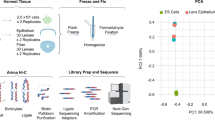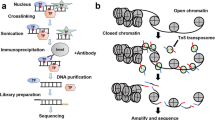Abstract.
We show that methylated lysine 9 of histone H3 (Me9H3) is a marker of heterochromatin in divergent animal species. It localises to both constitutive and facultative heterochromatin and replicates late in S-phase of the cell cycle. Significantly, Me9H3 is enriched in the inactive mammalian X chromosome (Xi) in female cells, as well as in the XY body during meiosis in the male, and forms a G-band pattern along the arms of the autosomes. Me9H3 is a constituent of imprinted chromosomes that are repressed. The paternal and maternal pronuclei in one-cell mouse embryos show a striking non-equivalence in Me9H3: the paternal pronucleus contains no immunocytologically detectable Me9H3. The levels of Me9H3 on the parental chromosomes only become equivalent after the two-cell stage. Finally, we provide evidence that Me9H3 is neither necessary nor sufficient for localisation of heterochromatin protein 1 (HP1) to chromosomal DNA.
Similar content being viewed by others
Author information
Authors and Affiliations
Additional information
Electronic Publication
Rights and permissions
About this article
Cite this article
Cowell, I.G., Aucott, R., Mahadevaiah, S.K. et al. Heterochromatin, HP1 and methylation at lysine 9 of histone H3 in animals. Chromosoma 111, 22–36 (2002). https://doi.org/10.1007/s00412-002-0182-8
Received:
Revised:
Accepted:
Issue Date:
DOI: https://doi.org/10.1007/s00412-002-0182-8




